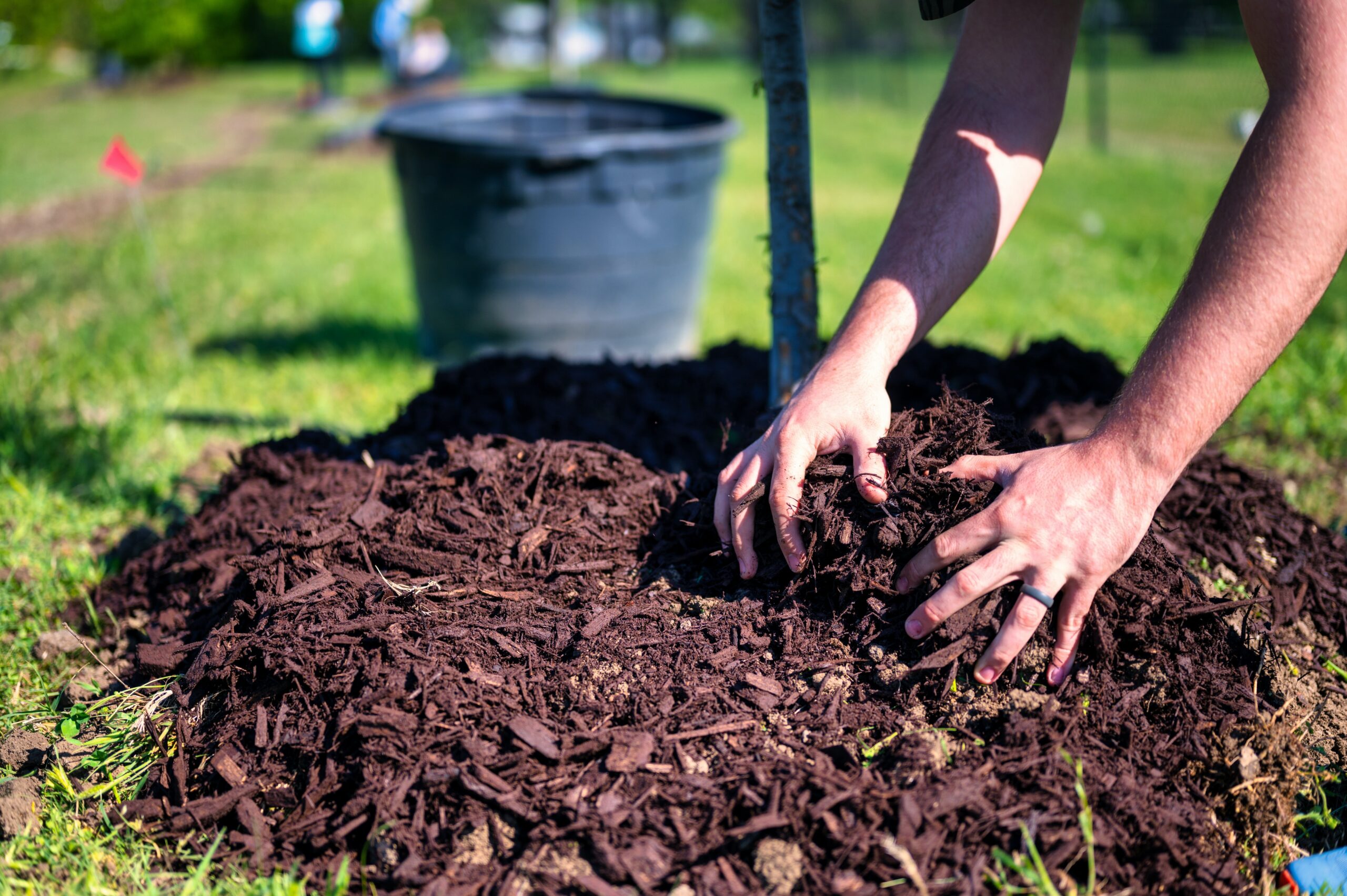Mulching a garden is a common gardening practice that involves covering the soil around plants with a layer of organic or inorganic material. Mulch serves several purposes and can provide various benefits for your garden. Here’s how to mulch a garden:
Materials for Mulching:
1. Organic Mulch:
- Compost: Compost is a mixture of decomposed organic materials such as food scraps, leaves, grass clippings, and more. Compost provides nutrients to plants over time.
- Straw: Dry straw is an excellent protective layer for the soil. It helps retain soil moisture and shields plants from extreme temperature changes.
- Wood Chips: Wood chips are a popular choice for organic mulch. They come in various sizes and can provide weed protection and soil moisture retention.
- Leaves: Shredded and decomposed leaves can be used as organic mulch. They help prevent weed growth and enhance soil fertility over time.
2. Non-Organic Mulch:
- Gravel or Stones: Gravel or stones are durable and won’t decompose. These are usually used for decorative purposes or in areas where soil moisture needs to be controlled.
- Black Plastic: Black plastic can be used to suppress weed growth and maintain soil moisture. However, it might be less aesthetically pleasing and is more suitable for areas that aren’t directly visible.
- Newspaper: Layers of old newspaper can be used as a mulch that inhibits weed growth. This should be covered with organic mulch for added protection.
Tips for Choosing Mulch Materials:
- Choose mulch materials based on the needs of your plants and the environmental conditions in your area.
- Organic mulch provides additional nutrient benefits and improves soil structure.
- Non-organic mulch is generally longer-lasting and more suitable for areas requiring strong weed control.
- Consider the aesthetics and practicality of the mulch material you choose.
How to Apply Mulch:
- Clear the planting area of weeds and debris.
- Water the plants if needed.
- Spread the mulch material with a thickness of about 2-4 inches (5-10 cm) around the plants.
- Avoid piling mulch directly around the plant stems.
- Consider keeping the area around plant stems open to allow air and sunlight to reach the soil.
Remember, the main purpose of mulch is to provide protection, retain moisture, and improve the soil. The choice of mulch material depends on personal preference, plant types, and environmental conditions in your area.
Steps to Mulch a Garden:
-
Prepare the Garden Area:
- Clear the garden bed of any weeds, debris, or old mulch. Rake the soil to create a smooth and even surface.
- If needed, water the plants thoroughly before mulching to ensure the soil is adequately moist.
-
Select the Mulch Material:
- Choose the type of mulch that best suits your garden’s needs. Consider factors such as plant type, climate, and desired aesthetic.
- Calculate the amount of mulch you’ll need based on the size of the garden bed and the recommended mulch thickness.
-
Apply a Weed Barrier (Optional):
- If desired, you can lay down a weed barrier fabric before applying the mulch. This fabric helps prevent weed growth while allowing water and air to pass through.
-
Spread the Mulch:
- Start spreading the chosen mulch material evenly over the prepared garden bed. Use a rake or shovel to distribute the mulch to a uniform thickness.
- Maintain a thickness of about 2 to 4 inches (5-10 cm) of mulch. Avoid piling mulch against plant stems, as this can lead to moisture-related issues.
-
Mulch Around Plants:
- Create a ring of clear space around the base of each plant. This prevents the mulch from touching the stems, reducing the risk of rot and pest issues.
- Gently pull the mulch away from plant stems to create a donut-shaped ring.
-
Water the Mulched Area:
- After mulching, water the garden bed thoroughly. The mulch will help retain moisture, promoting healthy root growth and reducing water evaporation.
-
Maintain the Mulch Layer:
- Over time, the mulch will settle and break down. Periodically check the mulch thickness and add more mulch as needed to maintain the recommended depth.
- For organic mulch, you may need to replenish it annually as it decomposes and enriches the soil.
-
Monitor and Adjust:
- Keep an eye on the garden bed to ensure the mulch is performing its intended functions, such as weed suppression and moisture retention.
- Adjust the mulch layer as necessary and make any needed changes based on the health and growth of your plants.
Note: Different plants may have specific mulching requirements, so it’s a good idea to research the preferences of the plants in your garden.
Mulching is a beneficial practice, but proper application and maintenance are essential for optimal results.
Benefits of Mulching:
-
Weed Control:
- Mulching creates a physical barrier that prevents weed seeds from receiving sunlight, inhibiting their germination and growth.
- This reduces the competition between weeds and your garden plants for water, nutrients, and sunlight.
-
Moisture Retention:
- Mulch acts as a protective layer that helps reduce soil evaporation by blocking direct exposure to the sun and wind.
- By retaining moisture in the soil, mulching reduces the need for frequent watering, conserving water resources and promoting healthier plant growth.
-
Temperature Regulation:
- Mulch acts as an insulating layer that helps regulate soil temperatures. It keeps the soil cooler in hot weather and provides some protection against frost in colder seasons.
- Stable soil temperatures promote better root development and protect plants from temperature-related stress.
-
Soil Health Improvement:
- Organic mulches gradually decompose, adding organic matter to the soil. This improves soil structure, enhances water-holding capacity, and promotes beneficial microbial activity.
- Nutrients released during decomposition enrich the soil, providing a natural source of fertilizer for plants.
-
Erosion Prevention:
- Mulch helps prevent soil erosion by absorbing the impact of heavy raindrops, reducing the risk of soil particles being washed away.
- The mulch layer also prevents water runoff, allowing more water to infiltrate the soil.
-
Disease Prevention:
- Properly applied mulch can act as a protective barrier between soil and plant leaves, reducing the chances of soil-borne diseases splashing onto plants during rainfall or irrigation.
-
Improved Aesthetics:
- Mulch provides a neat and uniform appearance to garden beds, enhancing the overall visual appeal of your landscape.
- Different types of mulch can be chosen for their color and texture to complement the design of your garden.
-
Reduced Soil Compaction:
- Mulch can help reduce soil compaction by acting as a cushion, allowing better water penetration and root growth.
- Less compacted soil provides better aeration and nutrient uptake for plants.
-
Ease of Maintenance:
- Mulched areas generally have fewer weeds, making garden maintenance tasks like weeding less time-consuming.
- Mulch also prevents soil from splashing onto leaves during heavy rains, reducing the need for leaf cleaning.
-
Protection Against Pests:
- Some types of mulch, such as cedar chips or pine needles, may have natural pest-repelling properties, helping to deter certain insects from infesting your garden.
Remember that the effectiveness of mulching depends on proper application and maintenance.
Choosing the right type of mulch for your garden’s specific needs and regularly monitoring its condition will ensure that you maximize these benefits and create a healthier and more vibrant garden environment.

